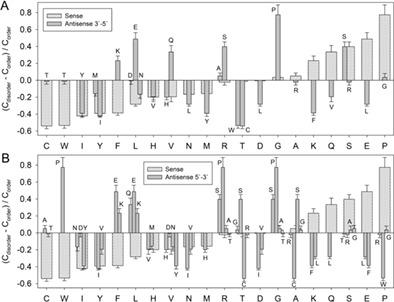当前位置:
X-MOL 学术
›
J. Mol. Recognit.
›
论文详情
Our official English website, www.x-mol.net, welcomes your
feedback! (Note: you will need to create a separate account there.)
Intrinsic disorder in protein sense-antisense recognition.
Journal of Molecular Recognition ( IF 2.3 ) Pub Date : 2020-06-22 , DOI: 10.1002/jmr.2868 Guy W Dayhoff 1 , Marc H V van Regenmortel 2 , Vladimir N Uversky 3, 4
Journal of Molecular Recognition ( IF 2.3 ) Pub Date : 2020-06-22 , DOI: 10.1002/jmr.2868 Guy W Dayhoff 1 , Marc H V van Regenmortel 2 , Vladimir N Uversky 3, 4
Affiliation

|
In addition to the well‐established sense‐antisense complementarity abundantly present in the nucleic acid world and serving as a basic principle of the specific double‐helical structure of DNA, production of mRNA, and genetic code‐based biosynthesis of proteins, sense‐antisense complementarity is also present in proteins, where sense and antisense peptides were shown to interact with each other with increased probability. In nucleic acids, sense‐antisense complementarity is achieved via the Watson‐Crick complementarity of the base pairs or nucleotide pairing. In proteins, the complementarity between sense and antisense peptides depends on a specific hydropathic pattern, where codons for hydrophilic and hydrophobic amino acids in a sense peptide are complemented by the codons for hydrophobic and hydrophilic amino acids in its antisense counterpart. We are showing here that in addition to this pattern of the complementary hydrophobicity, sense and antisense peptides are characterized by the complementary order‐disorder patterns and show complementarity in sequence distribution of their disorder‐based interaction sites. We also discuss how this order‐disorder complementarity can be related to protein evolution.
中文翻译:

蛋白质有义-反义识别的内在障碍。
除了广泛存在于核酸世界中并作为 DNA 特定双螺旋结构、mRNA 生产和基于遗传密码的蛋白质生物合成的基本原理的公认的有义-反义互补性之外,有义-反义互补性也存在于蛋白质中,其中有义和反义肽显示出以增加的可能性彼此相互作用。在核酸中,有义-反义互补是通过碱基对或核苷酸配对的沃森-克里克互补来实现的。在蛋白质中,有义和反义肽之间的互补性取决于特定的亲水模式,其中有义肽中亲水性和疏水性氨基酸的密码子与反义对应物中疏水性和亲水性氨基酸的密码子互补。我们在这里展示了除了这种互补疏水性模式之外,有义和反义肽的特征在于互补的有序-无序模式,并在基于无序的相互作用位点的序列分布中显示出互补性。我们还讨论了这种有序-无序互补性如何与蛋白质进化相关。
更新日期:2020-06-22
中文翻译:

蛋白质有义-反义识别的内在障碍。
除了广泛存在于核酸世界中并作为 DNA 特定双螺旋结构、mRNA 生产和基于遗传密码的蛋白质生物合成的基本原理的公认的有义-反义互补性之外,有义-反义互补性也存在于蛋白质中,其中有义和反义肽显示出以增加的可能性彼此相互作用。在核酸中,有义-反义互补是通过碱基对或核苷酸配对的沃森-克里克互补来实现的。在蛋白质中,有义和反义肽之间的互补性取决于特定的亲水模式,其中有义肽中亲水性和疏水性氨基酸的密码子与反义对应物中疏水性和亲水性氨基酸的密码子互补。我们在这里展示了除了这种互补疏水性模式之外,有义和反义肽的特征在于互补的有序-无序模式,并在基于无序的相互作用位点的序列分布中显示出互补性。我们还讨论了这种有序-无序互补性如何与蛋白质进化相关。











































 京公网安备 11010802027423号
京公网安备 11010802027423号